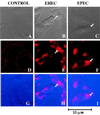Interaction of enteropathogenic or enterohemorrhagic Escherichia coli with HeLa cells results in translocation of cortactin to the bacterial adherence site
- PMID: 10603412
- PMCID: PMC97145
- DOI: 10.1128/IAI.68.1.382-386.2000
Interaction of enteropathogenic or enterohemorrhagic Escherichia coli with HeLa cells results in translocation of cortactin to the bacterial adherence site
Abstract
Infection of cultured HeLa epithelial cells with enteropathogenic Escherichia coli (EPEC) or enterohemorrhagic E. coli (EHEC) O157:H7 results in accumulation of cortactin under the adherent bacteria. Tyrosine phosphorylation of cortactin is not induced following HeLa cell infection with EHEC or EPEC, contrary to what has been reported to occur with Shigella flexneri.
Figures



Similar articles
-
Enterohemorrhagic Escherichia coli O157:H7 produces Tir, which is translocated to the host cell membrane but is not tyrosine phosphorylated.Infect Immun. 1999 May;67(5):2389-98. doi: 10.1128/IAI.67.5.2389-2398.1999. Infect Immun. 1999. PMID: 10225900 Free PMC article.
-
Cortactin is essential for F-actin assembly in enteropathogenic Escherichia coli (EPEC)- and enterohaemorrhagic E. coli (EHEC)-induced pedestals and the alpha-helical region is involved in the localization of cortactin to bacterial attachment sites.Cell Microbiol. 2006 May;8(5):769-80. doi: 10.1111/j.1462-5822.2005.00664.x. Cell Microbiol. 2006. PMID: 16611226
-
Invasion of epithelial cells by Shigella flexneri induces tyrosine phosphorylation of cortactin by a pp60c-src-mediated signalling pathway.EMBO J. 1995 Jun 1;14(11):2471-82. doi: 10.1002/j.1460-2075.1995.tb07244.x. EMBO J. 1995. PMID: 7540134 Free PMC article.
-
[Mechanism of A/E lesion formation produced by enterohemorrhagic Escherichia coli: O157--role of EspB, Tir and cortactin].Nihon Rinsho. 2002 Jun;60(6):1101-7. Nihon Rinsho. 2002. PMID: 12078080 Review. Japanese.
-
Tails of two Tirs: actin pedestal formation by enteropathogenic E. coli and enterohemorrhagic E. coli O157:H7.Curr Opin Microbiol. 2003 Feb;6(1):82-90. doi: 10.1016/s1369-5274(03)00005-5. Curr Opin Microbiol. 2003. PMID: 12615225 Review.
Cited by
-
The cytoskeletal scaffold Shank3 is recruited to pathogen-induced actin rearrangements.Exp Cell Res. 2009 Jul 15;315(12):2001-11. doi: 10.1016/j.yexcr.2009.04.003. Epub 2009 Apr 14. Exp Cell Res. 2009. PMID: 19371741 Free PMC article.
-
Cytoskeletal mechanisms regulating attaching/effacing bacteria interactions with host cells: It takes a village to build the pedestal.Bioessays. 2024 Nov;46(11):e2400160. doi: 10.1002/bies.202400160. Epub 2024 Sep 20. Bioessays. 2024. PMID: 39301984 Review.
-
Serine protease EspP from enterohemorrhagic Escherichia coli is sufficient to induce shiga toxin macropinocytosis in intestinal epithelium.PLoS One. 2013 Jul 18;8(7):e69196. doi: 10.1371/journal.pone.0069196. Print 2013. PLoS One. 2013. PMID: 23874912 Free PMC article.
-
A novel pseudopodial component of the dendritic cell anti-fungal response: the fungipod.PLoS Pathog. 2010 Feb 12;6(2):e1000760. doi: 10.1371/journal.ppat.1000760. PLoS Pathog. 2010. PMID: 20169183 Free PMC article.
-
Recruitment of cytoskeletal and signaling proteins to enteropathogenic and enterohemorrhagic Escherichia coli pedestals.Infect Immun. 2001 May;69(5):3315-22. doi: 10.1128/IAI.69.5.3315-3322.2001. Infect Immun. 2001. PMID: 11292754 Free PMC article.
References
-
- Donnenberg M S, Kaper J B, Finlay B B. Interaction between enteropathogenic Escherichia coli and host epithelial cells. Trends Microbiol. 1997;5:109–114. - PubMed
-
- Elliott S J, Wainwright L A, MacDaniel T K, Jarvis K G, Deng Y, Lai L-C, McNamara B P, Donnenberg M S, Kaper J B. The complete sequence of the locus of enterocyte effacement (LEE) from enteropathogenic Escherichia coli E2348/69. Mol Microbiol. 1998;28:1–4. - PubMed
Publication types
MeSH terms
Substances
LinkOut - more resources
Full Text Sources
Miscellaneous

